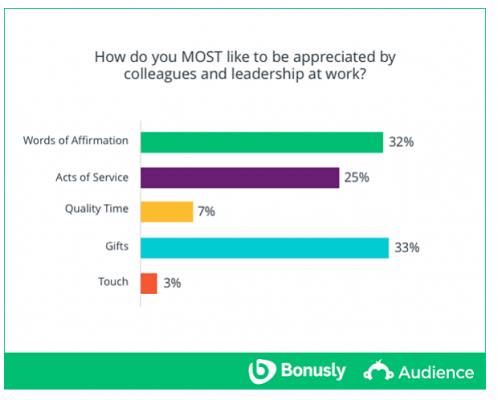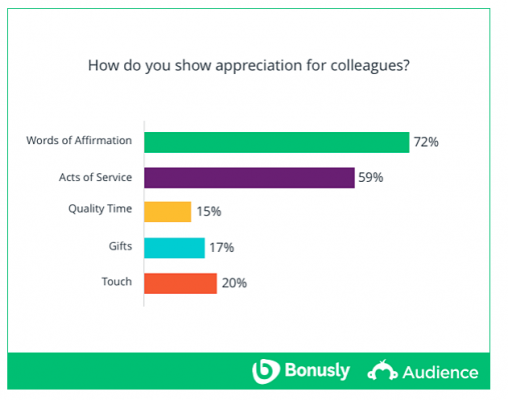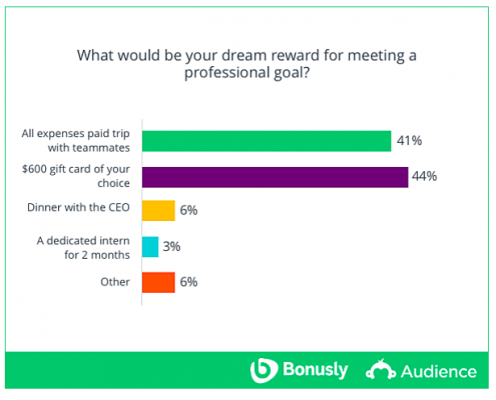It’s almost Valentine’s Day! Has an enthusiastic partner ever asked you about your “love language”? They’re basically asking what matters more to you—kisses, chocolates, or maybe a nice dinner together. What if it was your employer asking you the same question (in a totally HR-friendly way)?
The famous 5 Love Languages—Words of Affirmation, Acts of Service, Quality Time, Physical Touch, and Gifts—were originally laid out by Gary Chapman, a philosophy PhD, author, and talk show host. Less famously, Chapman also wrote about the 5 Love Languages at work, the same 5 concepts—but office appropriate.
That got us curious, and we partnered with Bonusly and turned to over 1,500 people on SurveyMonkey Audience to dig a little deeper. How do people show appreciation at work? What do they want in return? Is there a connection between people’s romantic love language and their professional one? Are they even...the same?
As it turns out—heck no! People want quality time with their loved ones and gifts from their employers, thank you very much. But there were still some interesting and surprising takeaways about how people give and receive appreciation at work.
How the 5 Love Languages apply to the office
Here’s a simplified chart to help explain how the Love Languages pan out in the office.

5 Findings about the 5 Love Languages at work
Words matter. There are 2 winners when it comes to the top love language for receiving appreciation: Gifts (33%) and Words of Affirmation (32%). It seems obvious that people would be interested in physical gifts from their employers, but it turns out that praise is equally important.

On top of that, almost everyone (73%) uses Words of Affirmation to show their appreciation to colleagues.

And there’s another interesting factor: Words may actually play into tangible rewards (Gifts)—68% think that public recognition and praise has at least some impact on their ability to get a raise or promotion.
There’s a place for Physical Touch in the workplace after all. Next, let’s address that with the thing you’re probably wondering about most—touch. Chapman (and our survey) defined physical touch in the workplace as handshakes, high fives, and maybe even a literal pat on the back.
20% of people use physical touch to show appreciation at work, and 3% considered it their primary love language.
There are generational differences. People ages 18-29 have different preferences than workers who are older. For one thing, they’re more than twice as likely to select “Quality Time” as a way that they bond with/show appreciation to colleagues. Older employees are less interested in quality time (maybe because they’re more likely to have families to get home to?) and more interested in cash bonuses.
Younger people and older people also have different “dream rewards.” We offered respondents a choice between quality time with the CEO of their company, a gift card, a prepaid trip with colleagues, or a dedicated intern. Overall, the gift card was the most popular gift, but among millennials, it was all about the trip.
Here’s the breakdown for a “dream gift” in the population overall.

Women care about Acts of Service, men like team bonding. Women were much more likely to crave and show appreciation through Acts of Service at work—think getting coffee for a colleague, taking notes for someone who is out. A full 59% of women list it among their top love languages vs. only 41% of men. Men, on the other hand, lean much more heavily toward Quality Time and team bonding (61% vs. 39% of women).
Everyone wants Quality Time in love—but not at work. Team bonding might make the top few choices among men, but when it came time to choose a number 1 love language, only 7% of people chose Quality Time. That’s especially striking because a whopping 50% of respondents consider Quality Time their number 1 love language in personal life.
In-person bonding is just not that valuable to people if it means spending more time at work, or with people who remind them of work.
Understanding the Love Language of yourself and the people around you helps you be part of an office culture where everyone feels appreciated. And work is much better when you’re surrounded by happiness and respect, don’t you think?



